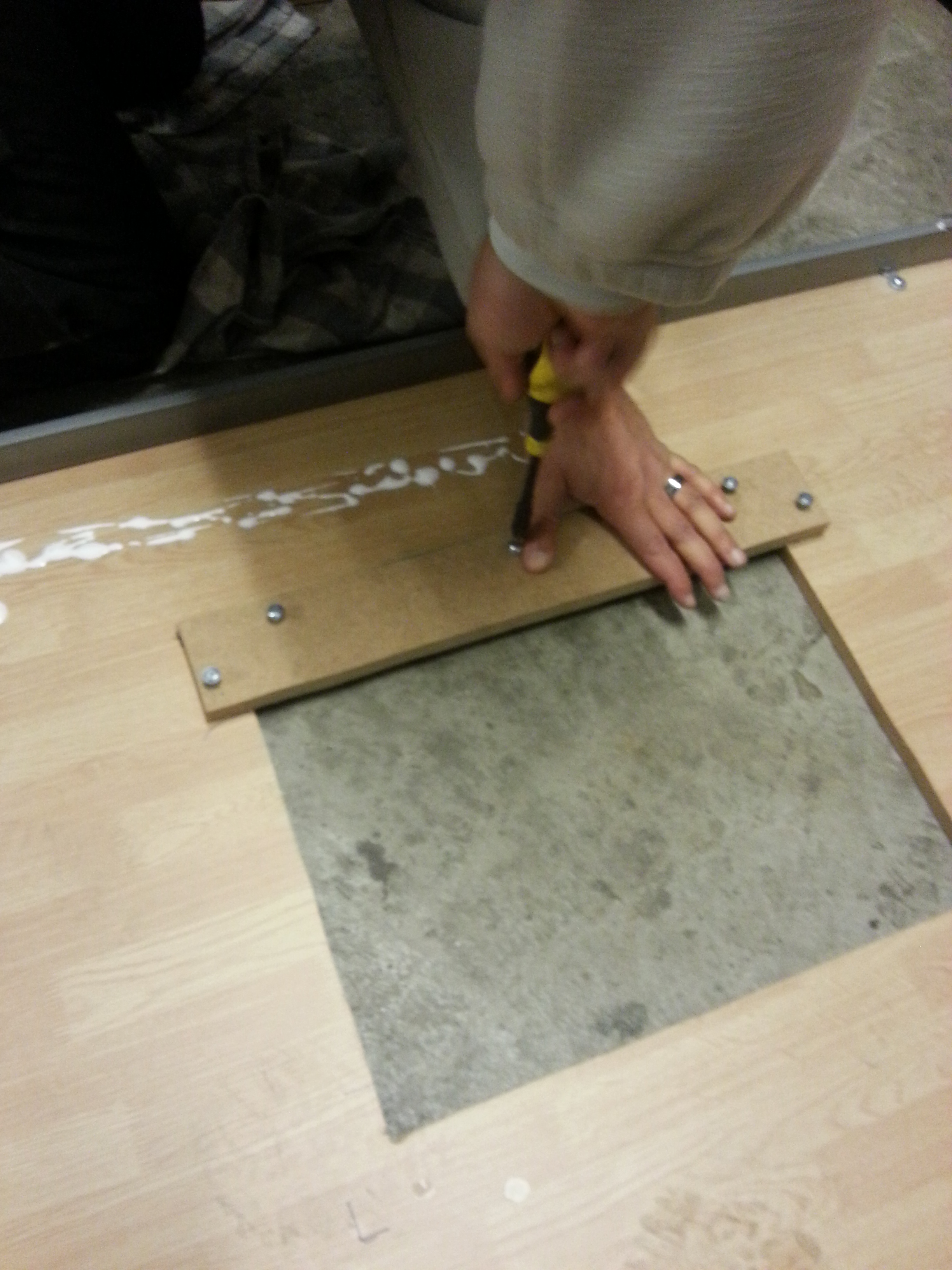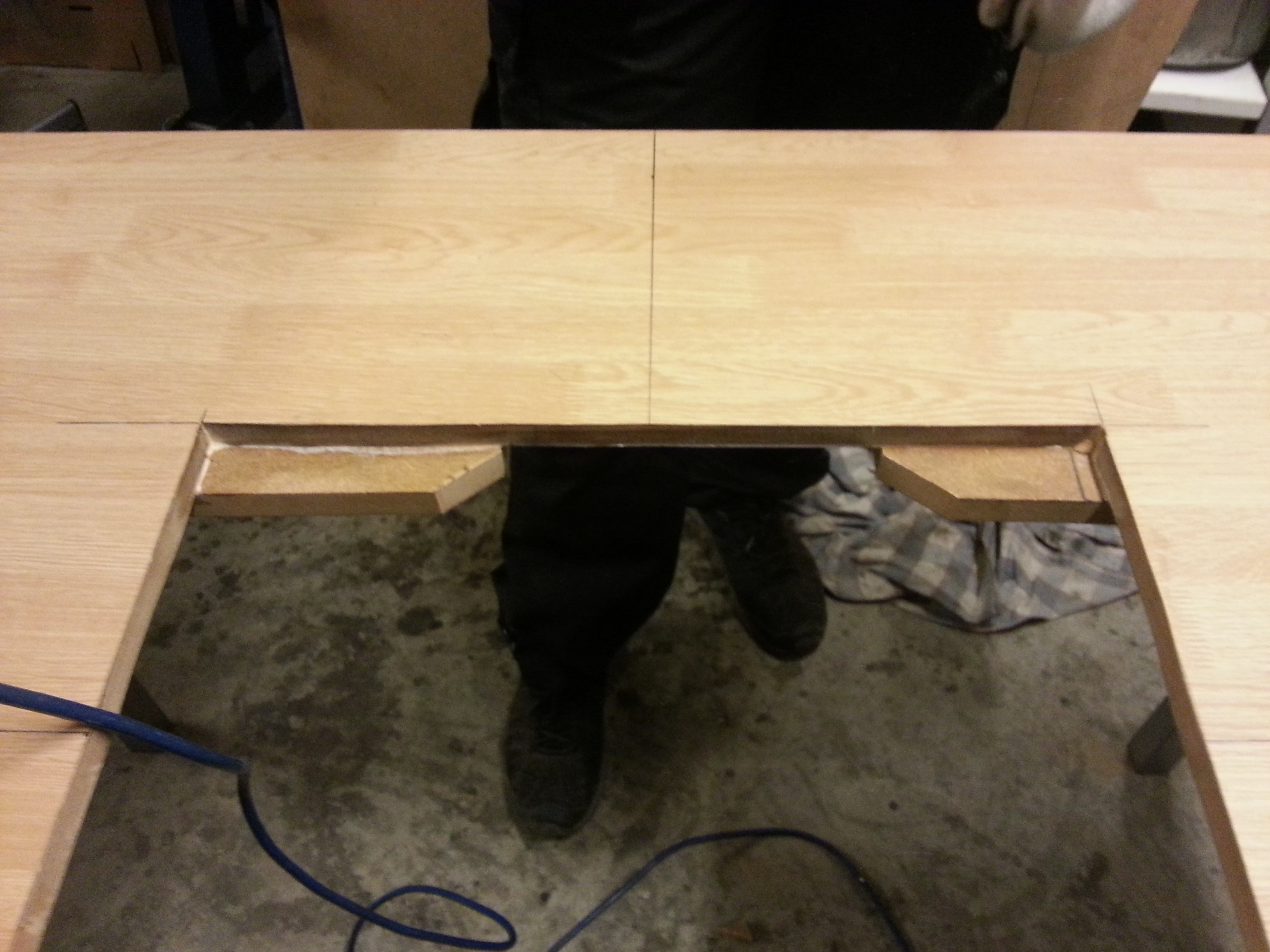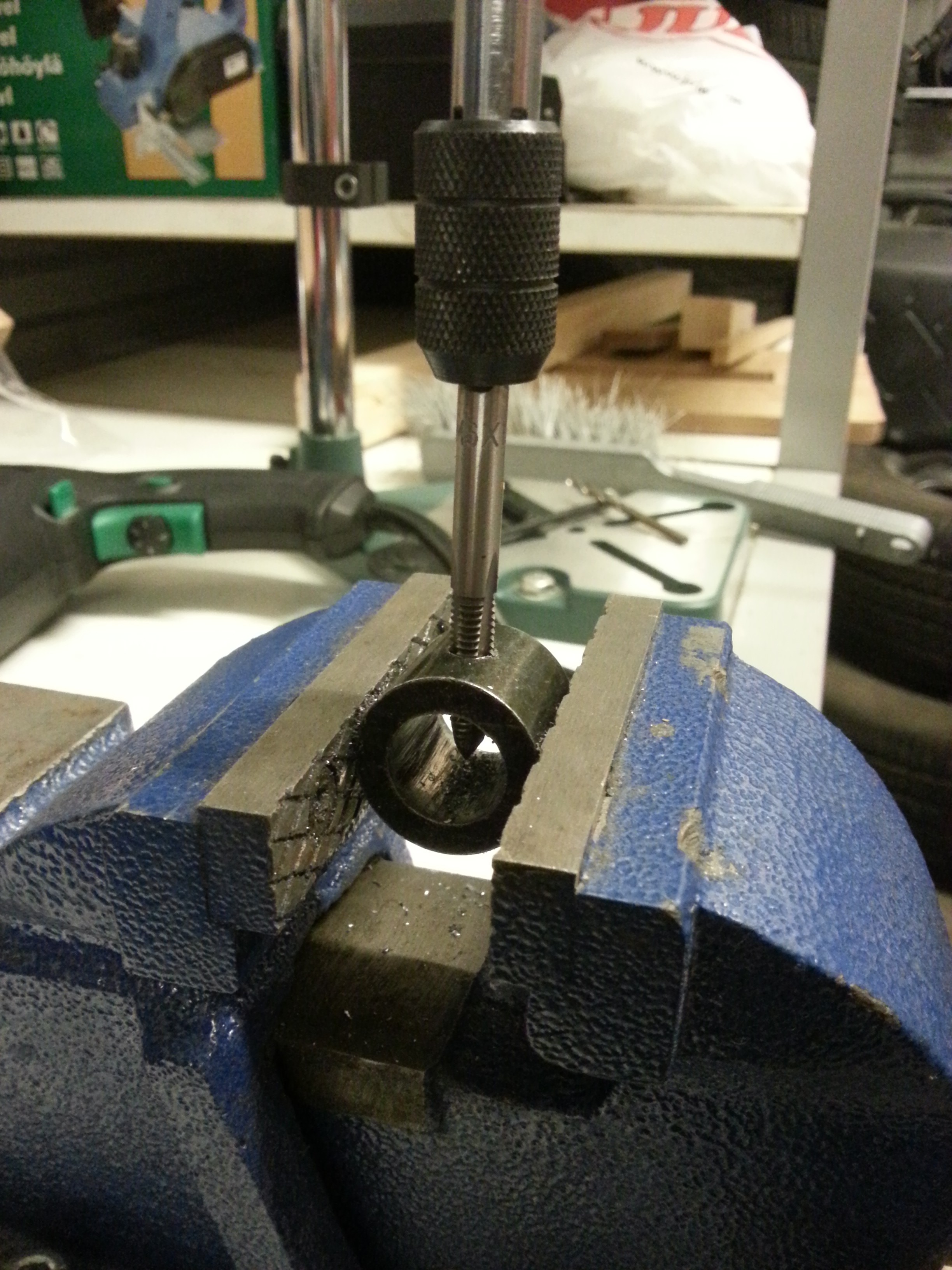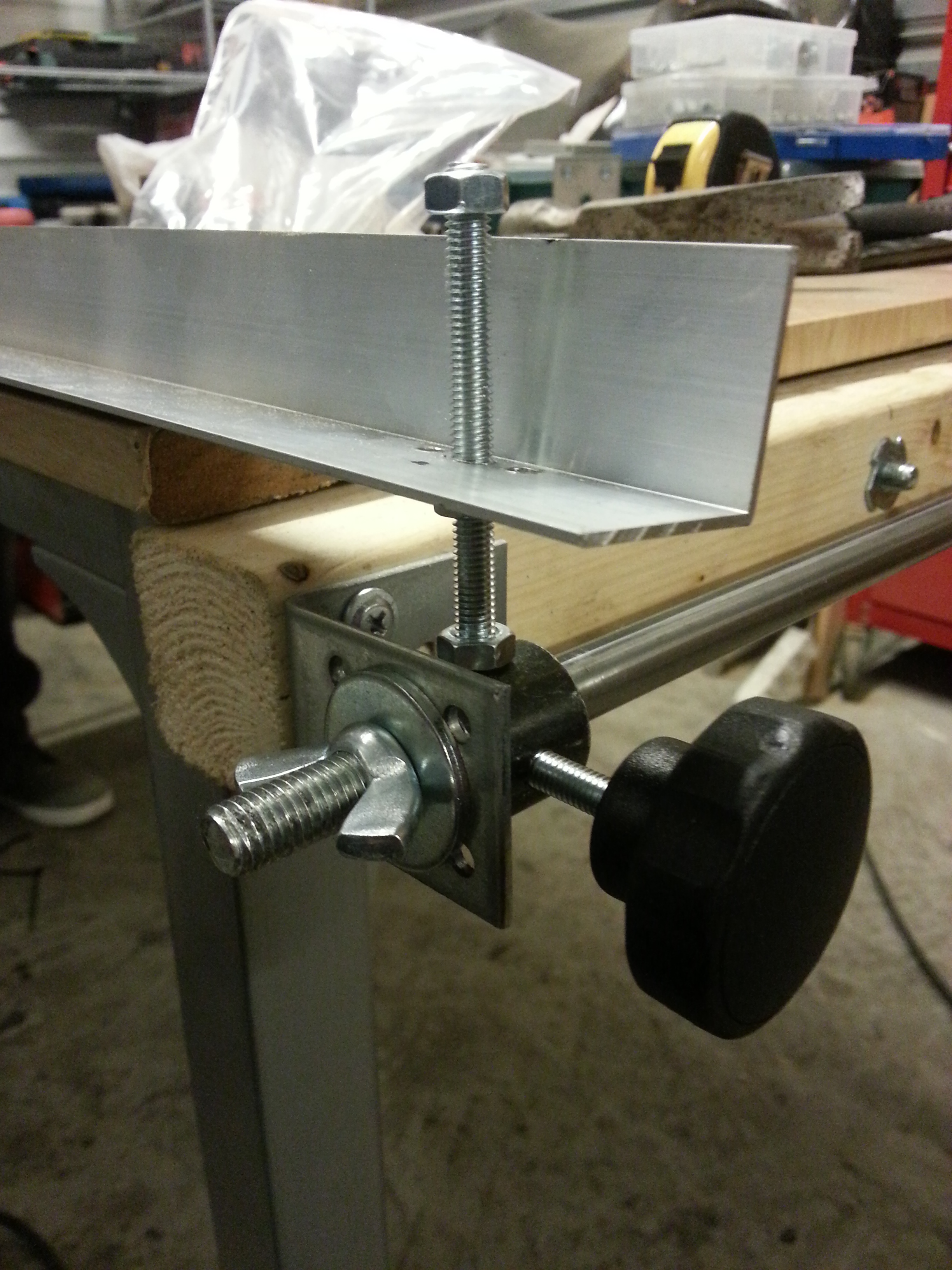Convert Hand Saw to Table Saw
by H.C. in Workshop > Woodworking
89071 Views, 537 Favorites, 0 Comments
Convert Hand Saw to Table Saw




Hello everybody.
You probably like me, own a hand saw, but want a table saw, cause it's much stable and accurate then the hand held one.
Well this is my own try.
I tried to build a table saw, without spending allot of money, and I ended up with a pretty nice one, with a total coast of 1/5 of the original price of the cheapest table saw i found (the hand saw price not included).
I used Google sketch to draw a fast overview of what I had in my mind and it turned up very nice.
The idea is to make a table with a slot where I can use both a hand saw and a router. and still remove them and use them as hand held machines.
CAUTION:
I'M NOT TO BE HOLD RESPONSIBLE OF ANY KIND OF PERSONAL INJURIES OR MATERIAL LOST AND DAMAGE CAN BE CAUSED BY MY INSTRUCTION.
USE THE TOOLS WITH CAUTION, BE AWARE WHEN WORKING/ MANIPULATING ELECTRICAL MACHINES/COMPONENTS.
USE ALWAYS PROTECTION TOOLS. AND PROPER TOOLS.
You probably like me, own a hand saw, but want a table saw, cause it's much stable and accurate then the hand held one.
Well this is my own try.
I tried to build a table saw, without spending allot of money, and I ended up with a pretty nice one, with a total coast of 1/5 of the original price of the cheapest table saw i found (the hand saw price not included).
I used Google sketch to draw a fast overview of what I had in my mind and it turned up very nice.
The idea is to make a table with a slot where I can use both a hand saw and a router. and still remove them and use them as hand held machines.
CAUTION:
I'M NOT TO BE HOLD RESPONSIBLE OF ANY KIND OF PERSONAL INJURIES OR MATERIAL LOST AND DAMAGE CAN BE CAUSED BY MY INSTRUCTION.
USE THE TOOLS WITH CAUTION, BE AWARE WHEN WORKING/ MANIPULATING ELECTRICAL MACHINES/COMPONENTS.
USE ALWAYS PROTECTION TOOLS. AND PROPER TOOLS.
The Material/Tools Needed
















The material you will need is some common material that I think every one should have.
You will need:
Hand Saw.
Old table that you was thinking to throw away. (check on the scrap yard or your neighborhood if they got one that they don't need).
Some wood.
Drill / screwdrivers
Jigsaw.
Bolts
Nuts,(locknut work best as they resist the vibration from the saw).
Wing nuts.
Impact nuts.
Some Mounting Screws.
A ruler and a pen.
Threaded rod M10
Metal tube.
4 * 90 degrees brackets.
Terminal Block
Rotary switch
Aluminum L-shape to work as Fence, but you can use any type, even wood.
Grounded plug.
About 1m of grounded electrical cable.
You will need:
Hand Saw.
Old table that you was thinking to throw away. (check on the scrap yard or your neighborhood if they got one that they don't need).
Some wood.
Drill / screwdrivers
Jigsaw.
Bolts
Nuts,(locknut work best as they resist the vibration from the saw).
Wing nuts.
Impact nuts.
Some Mounting Screws.
A ruler and a pen.
Threaded rod M10
Metal tube.
4 * 90 degrees brackets.
Terminal Block
Rotary switch
Aluminum L-shape to work as Fence, but you can use any type, even wood.
Grounded plug.
About 1m of grounded electrical cable.
Measuring & Cutting the Hand Saw Slot.





I started by measuring the center of the table and marking it on the table surface.
Measure the hand saw cutting surface and determine the slot position and dimension on the table.
Once done, go ahead and draw it on the table.
Measure the blade on your jigsaw, then use the drill and drill 4 holes, one in every corner of the marked slot.
The holes should be big enough to let you slide the blade of the jigsaw without any problems.
Use the holes as a start position and cut out the slot.
Please comment my work..
Measure the hand saw cutting surface and determine the slot position and dimension on the table.
Once done, go ahead and draw it on the table.
Measure the blade on your jigsaw, then use the drill and drill 4 holes, one in every corner of the marked slot.
The holes should be big enough to let you slide the blade of the jigsaw without any problems.
Use the holes as a start position and cut out the slot.
Please comment my work..
Measuring & Cutting the Saw Blade Slot






Measure the Saw blade and determine the size of area you will need to cut out for the blade.
Draw the slot on the wood panel that you already cut out.
Use the drill and drill holes on the corners of that slot.
Once done, use the jigsaw and cut it out.
Test it on your Hand saw and adjust the slot if needed. (It's always better to cut a smaller slot then adjust, rather than a big one from the beginning).
Please comment my work..
Draw the slot on the wood panel that you already cut out.
Use the drill and drill holes on the corners of that slot.
Once done, use the jigsaw and cut it out.
Test it on your Hand saw and adjust the slot if needed. (It's always better to cut a smaller slot then adjust, rather than a big one from the beginning).
Please comment my work..
Attaching the Hand Saw to the Panel.






Mark and drill 4 small holes on the hand saw metal panel.
Drill 1 hole in each corner.
Measure the placement of the holes and mark the same places on the wood panel.
Measure the screw head and then use a drill as big as the screw head and drill some cuts on the marked places on the wood panel.
This will serve to make the screw head from sticking over the wood panel and by that don't prevent any thing from gliding through to the saw blade.
Once you done that, go ahead and finish drilling the holes with smaller drill with the same size as the threaded part of the screw.
Test the fitting of the screws on the wood panel, and then if everything is working as it should, finish the job by attaching the hand saw to the panel with screws and nuts.
Please comment my work..
Drill 1 hole in each corner.
Measure the placement of the holes and mark the same places on the wood panel.
Measure the screw head and then use a drill as big as the screw head and drill some cuts on the marked places on the wood panel.
This will serve to make the screw head from sticking over the wood panel and by that don't prevent any thing from gliding through to the saw blade.
Once you done that, go ahead and finish drilling the holes with smaller drill with the same size as the threaded part of the screw.
Test the fitting of the screws on the wood panel, and then if everything is working as it should, finish the job by attaching the hand saw to the panel with screws and nuts.
Please comment my work..
The Wood Panel Rack










Use 2 pieces of wood big enough to cover the wood panel hole/slot and attach them under the table.
Use mounting screws and wood glue.
The mounting screws should be long enough to hold the wood rack with the table, but not to stick out from the table.
Test the wood panel with the table.. for me I found out that the hand saw did not fit,
as the wood rack stopped the hand saw to fit on the slot.
Well I had to remove the rack and cut out the place where the saw engine was supposed to fit.
Please comment my work..
Use mounting screws and wood glue.
The mounting screws should be long enough to hold the wood rack with the table, but not to stick out from the table.
Test the wood panel with the table.. for me I found out that the hand saw did not fit,
as the wood rack stopped the hand saw to fit on the slot.
Well I had to remove the rack and cut out the place where the saw engine was supposed to fit.
Please comment my work..
Testing the Hand Saw Slot




This is turned to be a very nice result after all.. and I only spent 2-3h working on it until now.
Making the Fence Track












I used a bit of wood big enough to hold the 90 degree bracket, cause my table was not thick enough to hold it.
I pre-drilled for the bracket, then I used the mounting screws to attach it to the wood piece.
Once you ensure the brackets on the wood piece (one on each side), go ahead and mount the threaded rod in the holes of the bracket.
I used building brackets, as they come pre-drilled with mounting holes and a hole big enough to make my M10 rod pass through with no problem.
Don't forget to put the adjustable bracket on the threaded rod and ensure to put 2 wing nuts on the same rod.. one before and one after the adjustable bracket. (They will work as fixing nuts for the fence later).
The idea is to make the fence adjustable and movable along the threaded rods.
Attach the treaded rod to the brackets with lock nuts.. (This was a hard part, as the lock nuts was very hard to work with).
Do the same with the other fence track.
Update: 2012-10-27
Well as I was done with this I found out that it will take way too much time to slide the fence forward and backward along the track.
A new solution had to be found. and after a couple of hours thinking about it..
I modified the track a bit.
I started by adding a Metal pipe over the M10 rod.
The pipe had a 10mm of inner diameters and you can find those at any hardware store.
I found some brackets who was bigger in the inner diameters then the metal pipe, and thick enough to drill through.
Drill 2 holes on the bracket 90 degrees away from each other, then use a threaded tap to make them threaded.
Use any kind of screw you want as a lock knob. (I used old table leveler feet)
Use another longer screw on the other hole to serve as the fence attachment.
Please comment my work..
I pre-drilled for the bracket, then I used the mounting screws to attach it to the wood piece.
Once you ensure the brackets on the wood piece (one on each side), go ahead and mount the threaded rod in the holes of the bracket.
I used building brackets, as they come pre-drilled with mounting holes and a hole big enough to make my M10 rod pass through with no problem.
Don't forget to put the adjustable bracket on the threaded rod and ensure to put 2 wing nuts on the same rod.. one before and one after the adjustable bracket. (They will work as fixing nuts for the fence later).
The idea is to make the fence adjustable and movable along the threaded rods.
Attach the treaded rod to the brackets with lock nuts.. (This was a hard part, as the lock nuts was very hard to work with).
Do the same with the other fence track.
Update: 2012-10-27
Well as I was done with this I found out that it will take way too much time to slide the fence forward and backward along the track.
A new solution had to be found. and after a couple of hours thinking about it..
I modified the track a bit.
I started by adding a Metal pipe over the M10 rod.
The pipe had a 10mm of inner diameters and you can find those at any hardware store.
I found some brackets who was bigger in the inner diameters then the metal pipe, and thick enough to drill through.
Drill 2 holes on the bracket 90 degrees away from each other, then use a threaded tap to make them threaded.
Use any kind of screw you want as a lock knob. (I used old table leveler feet)
Use another longer screw on the other hole to serve as the fence attachment.
Please comment my work..
Attaching the Fence Track to the Table




Measure and mark on the wood part of the fence track where you will drill 2 mounting holes.
I found that using impact nuts is the most ideal solution for me.
Drill 2 holes on the wood and then measure again and drill 2 other holes on the table frame.
Make sure to drill the holes on the table frame at the same location where they meet the holes on the wood of the fence track.
Once done, hammer in the impact nuts on the holes.. Remember to use a drill head bigger with 1 size then the impact nut size.. it will make it easier to slide into the hole.
Attach the fence track to the table frame using bolts from behind the table frame.
use bolts that have almost the same length that are between the table frame and the fence track..
We don't need any bolts sticking out too much and stopping the bracket on the fence track from sliding free forward or backwards.
Please comment my work..
I found that using impact nuts is the most ideal solution for me.
Drill 2 holes on the wood and then measure again and drill 2 other holes on the table frame.
Make sure to drill the holes on the table frame at the same location where they meet the holes on the wood of the fence track.
Once done, hammer in the impact nuts on the holes.. Remember to use a drill head bigger with 1 size then the impact nut size.. it will make it easier to slide into the hole.
Attach the fence track to the table frame using bolts from behind the table frame.
use bolts that have almost the same length that are between the table frame and the fence track..
We don't need any bolts sticking out too much and stopping the bracket on the fence track from sliding free forward or backwards.
Please comment my work..
Attaching the Fence





Now it's time to mount the fence.
Start by fixing the track fence locking bracket and making sure that the fence mounting screw is perpendicular to the table.
mark on the fence where the mounting screw will be and drill 2 holes one in each side.
once done slide the fence over the screws and ensure to fix them with 2 nuts. once from above and one from under.
AND VOILA! The Table is done.
Now for some electrical work :)
Please comment my work..
Start by fixing the track fence locking bracket and making sure that the fence mounting screw is perpendicular to the table.
mark on the fence where the mounting screw will be and drill 2 holes one in each side.
once done slide the fence over the screws and ensure to fix them with 2 nuts. once from above and one from under.
AND VOILA! The Table is done.
Now for some electrical work :)
Please comment my work..
Making the Table Elctrical Switch








Sorry that it took long time to update..
lets see
DANGER...LIFE THREATENING....I'M NOT RESPONSIBLE FOR ANY DAMAGES OR INJURIES CAUSED BY THIS TUTORIAL
PROCEED AT OWN RISK
(Picture 1)
Start by drilling 2 or more holes on one of the table legs. they will serve to mount a tree plate to hold the electrical socket and
the rotary switch.
(Picture 2)
The tree plate has a double function, the first is to isolate against the metal leg of the table in case of electrical shortcut. and the second one to serve as good and stable hold.
(Picture 3+4)
Start by mounting the electrical socket to the tree panel, then connect the electrical cable, the yellow/green cable is the ground and should go on the middle.
Cut about 10cm from the electrical cable.
Connect the other electrical cable side to the rotary switch.. DO NOT SWITCH THE CABLE POSITIONS... CONNECT AS MY PICTURE IF POSSIBLE....
Close the electrical socket as the picture.
(Picture 5+6)
Mount the rotary switch socket to the tree panel right under the previous one.
then close the socket.
Finally connect the grounded plug to the end of the electrical cable.
Voila the ON/OFF switch is ready to start working.
All ideas and question are welcome.
lets see
DANGER...LIFE THREATENING....I'M NOT RESPONSIBLE FOR ANY DAMAGES OR INJURIES CAUSED BY THIS TUTORIAL
PROCEED AT OWN RISK
(Picture 1)
Start by drilling 2 or more holes on one of the table legs. they will serve to mount a tree plate to hold the electrical socket and
the rotary switch.
(Picture 2)
The tree plate has a double function, the first is to isolate against the metal leg of the table in case of electrical shortcut. and the second one to serve as good and stable hold.
(Picture 3+4)
Start by mounting the electrical socket to the tree panel, then connect the electrical cable, the yellow/green cable is the ground and should go on the middle.
Cut about 10cm from the electrical cable.
Connect the other electrical cable side to the rotary switch.. DO NOT SWITCH THE CABLE POSITIONS... CONNECT AS MY PICTURE IF POSSIBLE....
Close the electrical socket as the picture.
(Picture 5+6)
Mount the rotary switch socket to the tree panel right under the previous one.
then close the socket.
Finally connect the grounded plug to the end of the electrical cable.
Voila the ON/OFF switch is ready to start working.
All ideas and question are welcome.
Removing the Safety Trigger Switch






DANGER.. LIFE THREATING...PROCEED AT OWN RISK...I'M NOT RESPONSIBLE FOR ANY DAMAGE OR INJURIES CAUSED BY MY TUTORIAL
Start by removing all the screws holding the circle saw handle.
Once open.. unscrew the switch from the handle and then unscrew the wires out of it.. REMEMBER THE PLACEMENT OF THE WIRES.
Use a terminal block to connect the wires directly to each other.. in this case we bypass the trigger switch and the saw will turn ON every time you connect it to the electricity.
I used a plastic plug to cover the switch hole.. but electrical tape can do the same work and cover the holes. It can be a good idea to keep the dust from getting inside and with that eliminating the risk of fire or even getting electrocuted by mistake.
Once done close the handle and screw back everything in place.
Now connect the circle to the table electrical socket and you can use the rotary switch to turn the saw ON and OFF.
Start by removing all the screws holding the circle saw handle.
Once open.. unscrew the switch from the handle and then unscrew the wires out of it.. REMEMBER THE PLACEMENT OF THE WIRES.
Use a terminal block to connect the wires directly to each other.. in this case we bypass the trigger switch and the saw will turn ON every time you connect it to the electricity.
I used a plastic plug to cover the switch hole.. but electrical tape can do the same work and cover the holes. It can be a good idea to keep the dust from getting inside and with that eliminating the risk of fire or even getting electrocuted by mistake.
Once done close the handle and screw back everything in place.
Now connect the circle to the table electrical socket and you can use the rotary switch to turn the saw ON and OFF.